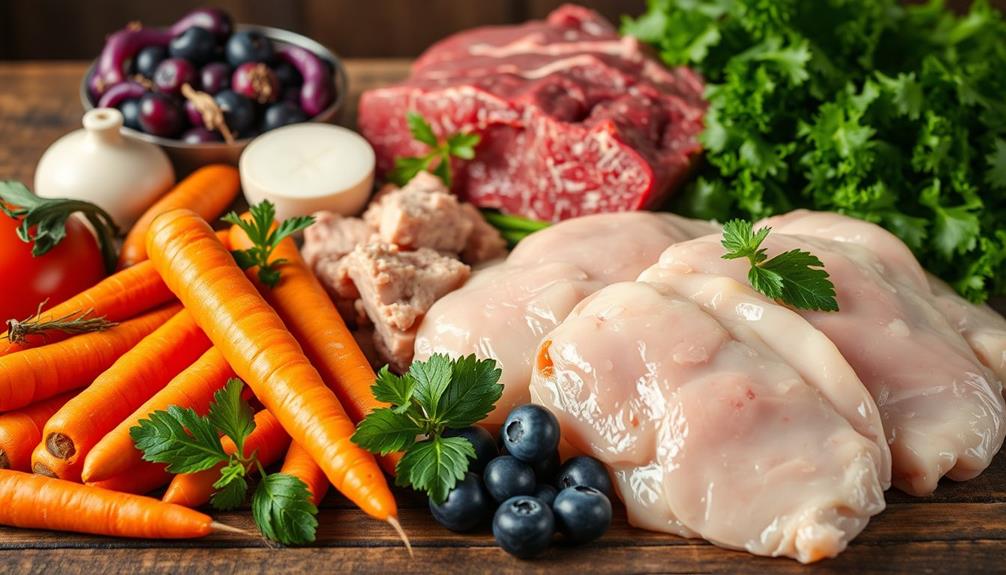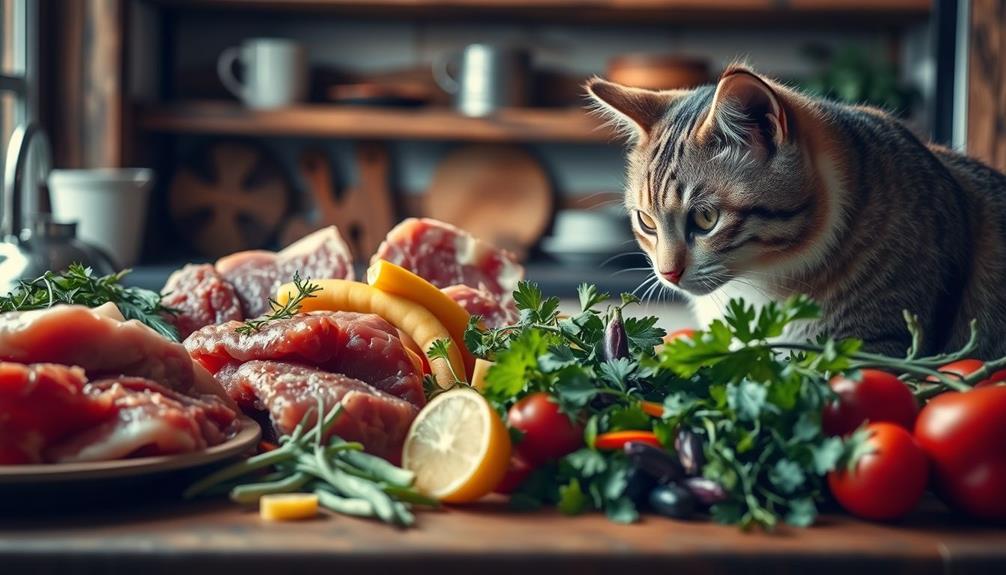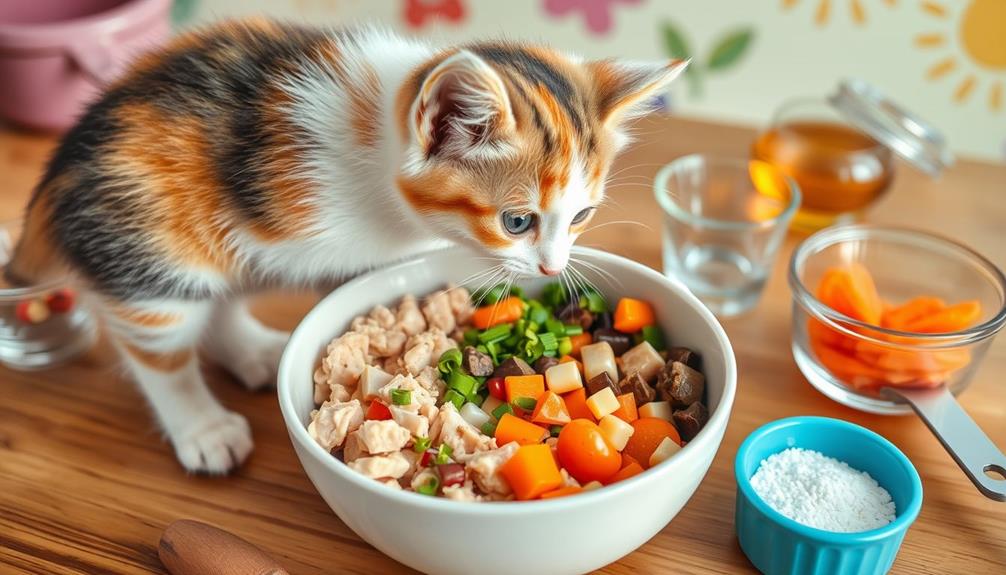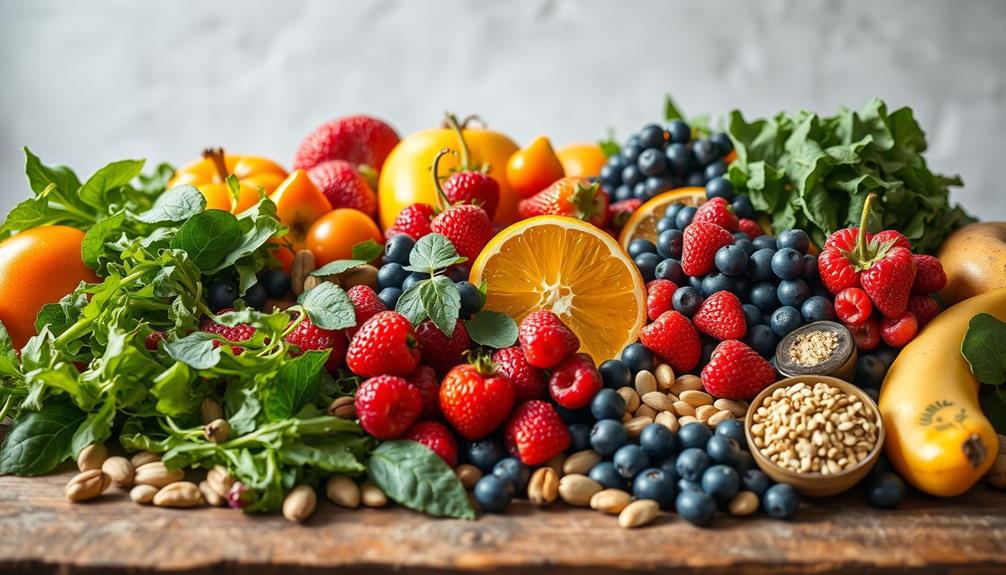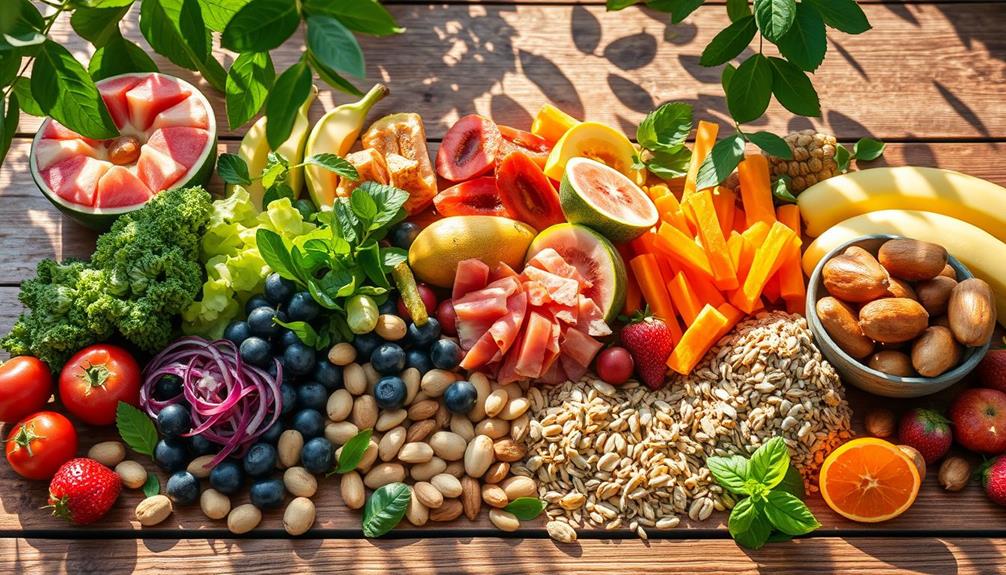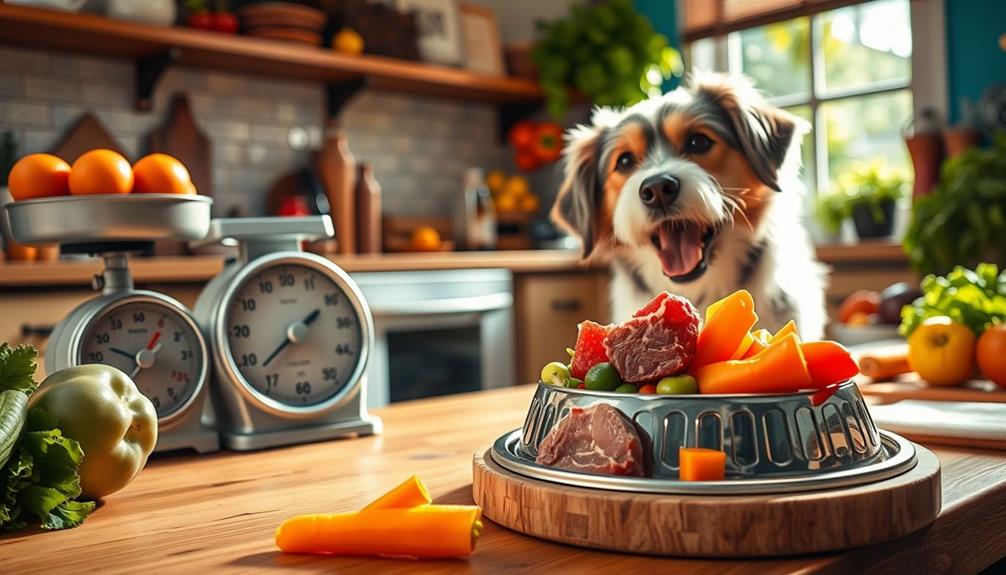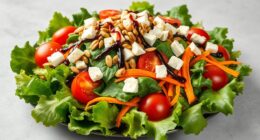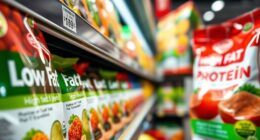You can give your dog a variety of raw foods, including muscle meats like chicken and beef, raw edible bones, and organ meats such as liver and heart. Add in safe veggies like carrots and sweet potatoes, plus fruits like blueberries and apples (without seeds). A balanced raw diet often follows the BARF model, featuring 70% meat, 10% bones, and 20% fruits and vegetables. Remember to shift slowly to avoid digestive upset and monitor your dog's health. Ready to explore safe handling tips and portion guidelines that guarantee your dog thrives on a raw food diet? When transitioning to a raw food diet for dogs, it’s important to consult with a veterinarian or a pet nutritionist to ensure that your dog is getting all the necessary nutrients. It’s also crucial to source high-quality, human-grade raw ingredients and to practice safe food handling to prevent contamination. With the right guidance and care, raw food for dogs can provide numerous health benefits and contribute to their overall well-being.
Key Takeaways
- Raw protein sources for dogs include muscle meats, organ meats, raw edible bones, and fish for essential nutrients and fatty acids.
- Vegetables like carrots and sweet potatoes, along with fruits such as blueberries and apples, provide vitamins, fiber, and antioxidants.
- Ensure a balanced raw diet with 70% muscle meat, 10% raw bone, 7% vegetables, and 10% organ meats (5% liver and 5% others).
- Gradually transition to raw food over 7-10 days, starting with 25% raw mixed with the current diet to avoid digestive upset.
- Always prioritize safe handling practices to reduce risks of bacterial contamination from raw food, including thorough cleaning and sanitation.
Understanding Raw Dog Food
When considering a raw dog food diet, it's important to understand its core components. Raw dog food primarily consists of uncooked meat, bones, organs, and sometimes fruits and vegetables, mimicking the natural diet of wild canines.
The BARF (Bones and Raw Food) diet emphasizes balanced nutrition, recommending a mix of 70% muscle meat, 10% raw edible bone, 7% vegetables, 5% liver, and 5% other organ meats. This balance helps guarantee your dog gets essential nutrients while minimizing the risk of nutritional deficiencies.
When you start feeding raw food, shifting to a raw diet should be gradual. Begin with a blend of 25% raw food mixed with 75% of your dog's current diet to prevent gastrointestinal upset. As your dog adjusts, you can increase the raw portion.
It's also beneficial to rotate between different protein sources, as each type offers unique nutritional benefits and helps prevent allergies.
Benefits of Raw Feeding
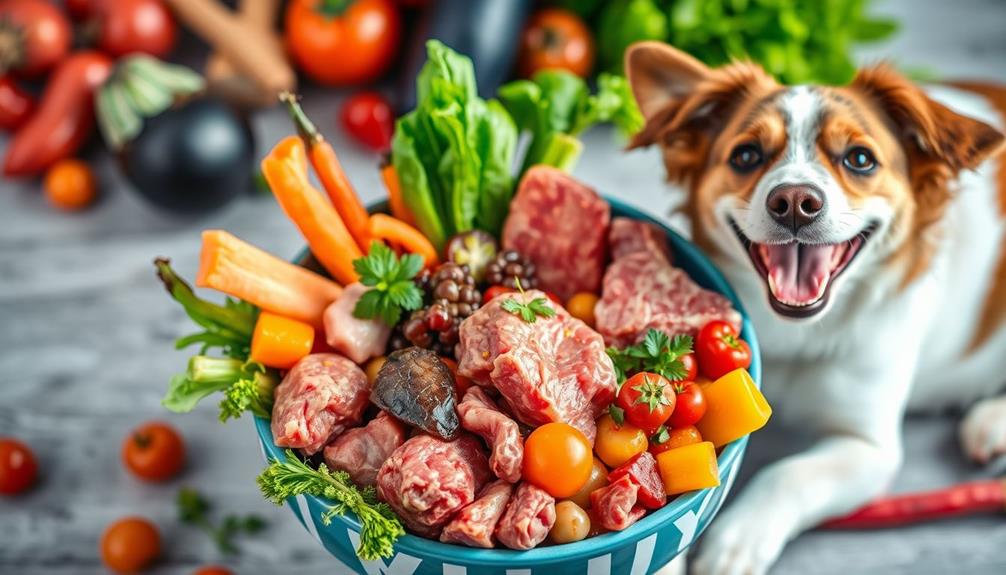
Raw feeding offers numerous advantages that can greatly enhance your dog's overall health and well-being. One of the most notable benefits is improved skin health and coat condition, thanks to the healthy fats and moisture found in raw ingredients. You'll likely notice a shinier coat and fewer skin issues.
Furthermore, dogs on a raw diet often experience increased energy levels, as this natural, unprocessed food aligns more closely with their evolutionary dietary needs. Additionally, as with cold medications, selecting the right raw ingredients can lead to better health outcomes for your pet.
Raw feeding promotes better digestion, leading to smaller and firmer stools. This means your dog absorbs more nutrients effectively compared to processed kibble. Enhanced digestion also contributes to overall dog health, resulting in a happier and more active pet.
Dental health is another advantage of a raw diet. Chewing on raw meat and bones helps reduce plaque buildup, supporting your dog's oral hygiene.
It's also worth noting that many advocates of raw feeding report reduced allergies and sensitivities in their pets. The absence of artificial additives and fillers commonly found in commercial dog foods can greatly benefit your dog's health.
Types of Raw Ingredients
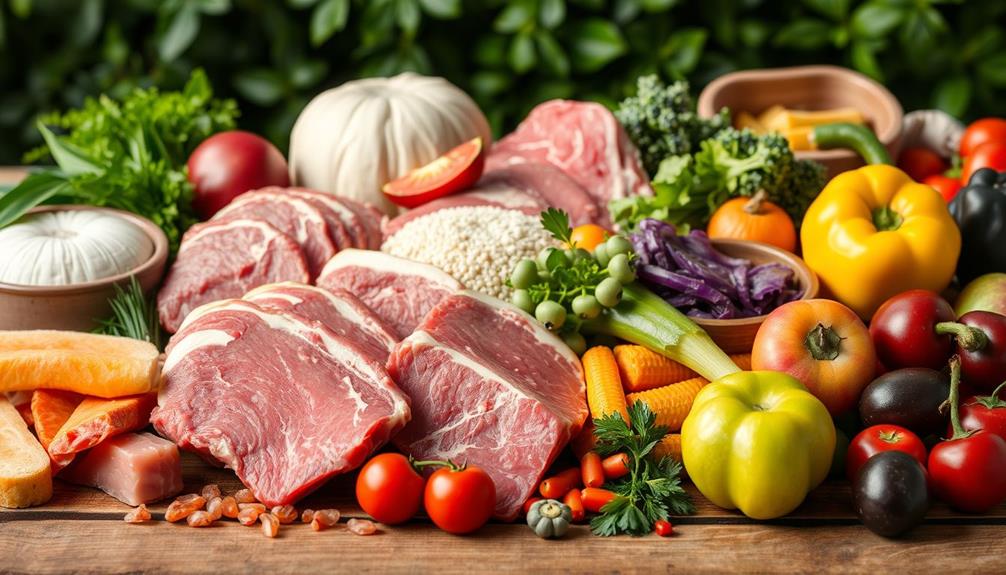
When choosing raw ingredients for your dog's diet, focus on quality protein sources like chicken, beef, or fish, which provide essential nutrients.
Incorporating healthy dog snacks made from natural ingredients can further enhance their overall wellness.
Don't forget to include safe vegetables and fruits, like carrots and blueberries, to boost their health.
It's important to select all ingredients from reputable suppliers to keep your pup safe from contamination.
Protein Sources for Dogs
Protein sources play an essential role in your dog's raw diet, making sure they receive the necessary nutrients they need to thrive. Start with muscle meats like chicken, beef, turkey, and lamb, which provide essential amino acids and energy important for your dog's overall health.
Incorporating essential oils for health into your dog's routine can also support their well-being. Don't forget organ meats, such as liver, heart, and kidney; these should make up about 10-15% of their diet and offer significant nutrients like vitamins A and B, iron, and taurine.
Incorporating raw edible bones, particularly from chicken or turkey, adds calcium and phosphorus, which are fundamental for strong bones and teeth. Just make sure the bones are soft to prevent dental damage.
Additionally, consider adding fish like salmon and sardines, as they're rich in omega-3 fatty acids that benefit your dog's skin, coat, and immune function.
Variety in protein sources is significant. Rotating different meats helps prevent food allergies and guarantees a well-rounded nutrient intake.
Safe Vegetables and Fruits
To create a balanced raw diet for your dog, it's important to include safe vegetables and fruits alongside the protein sources you've chosen. Safe vegetables like carrots, green beans, and sweet potatoes are excellent for providing essential vitamins and fiber while being low in calories. Fruits such as blueberries, apples (without seeds), and bananas can be offered as treats, supplying antioxidants and essential nutrients, but remember to give them in moderation due to their sugar content.
Leafy greens, including spinach and kale, can enhance nutrient intake, as they are rich in vitamins A, C, and K. To guarantee proper digestibility, prepare these vegetables by pureeing or steaming them, as dogs may struggle with raw plant material.
Always consult with a veterinarian before introducing new fruits and vegetables to verify they're safe and suitable for your dog's specific dietary needs.
| Safe Vegetables | Fruits | Benefits |
|---|---|---|
| Carrots | Blueberries | Antioxidants |
| Green Beans | Apples (no seeds) | Essential Vitamins |
| Sweet Potatoes | Bananas | Important Nutrients |
| Spinach | High in Vitamins A, C, K |
Risks and Safety Measures
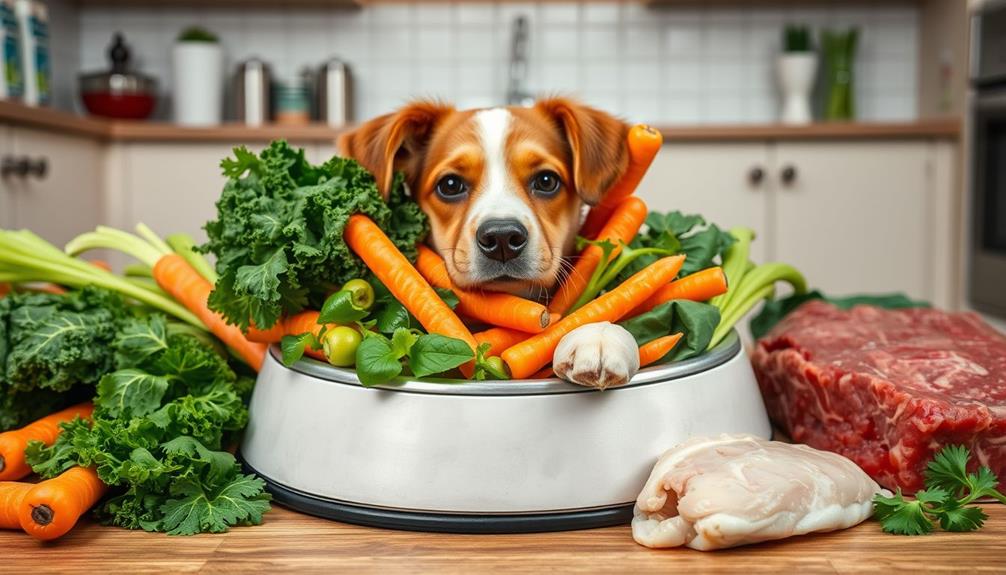
When you switch to a raw food diet for your dog, it's vital to be aware of bacterial contamination risks. This diet can introduce various pathogens, making it important to understand safe food handling practices.
Proper handling practices, like cleaning surfaces and utensils, help minimize these dangers. Additionally, making certain that your dog's feeding area is regularly sanitized can further reduce the risk of cross-contact contamination best practices for organizing prep tables.
Bacterial Contamination Risks
Handling raw food for dogs comes with significant bacterial contamination risks that you should be aware of. Raw meat can harbor harmful bacteria such as Salmonella and E. coli, posing health risks not just to dogs but also to you and your family. This makes proper handling and hygiene practices crucial.
Always wash your hands thoroughly and clean any surfaces that come into contact with raw meat to minimize contamination. Additionally, understanding common financial terms can help you budget for the costs involved in sourcing high-quality raw pet foods.
To further reduce bacterial risks, the FDA recommends freezing raw meat for at least 24 hours. This process can kill most bacteria and parasites without compromising the nutritional value of the food.
Additionally, consider sourcing high-quality raw pet foods, as bacterial contamination is more frequently found in these products compared to cooked meats.
Some manufacturers use High-Pressure Processing (HPP) to neutralize pathogens while preserving the food's nutritional integrity. This method can provide an added layer of safety when choosing raw food for your dog.
Safe Handling Practices
It's essential to prioritize safe handling practices when dealing with raw dog food to protect both your pet and your family. Always wash your hands thoroughly with soap and hot water after handling raw meat to minimize the risk of bacterial contamination like Salmonella and E. coli.
Additionally, understanding the importance of financial planning for pet care can help guarantee you're prepared for any unexpected health issues that may arise, as seen in financial considerations for elderly care. To further guarantee safety, use separate cutting boards for raw meat and other food items, preventing cross-contamination.
When preparing raw meat, freeze it at 0°F (-18°C) for at least 48 hours to kill parasites while maintaining its nutritional value. Remember to thaw raw meat in the refrigerator, never at room temperature, and avoid refreezing once it's thawed.
After preparing the food, sanitize all utensils and surfaces that touched the raw food.
As you introduce raw food to your dog's diet, always monitor your dog for any gastrointestinal upset. If you notice any adverse reactions, consult your veterinarian. Abrupt dietary changes can lead to health issues, so adapting gradually is key.
Transitioning to a Raw Diet
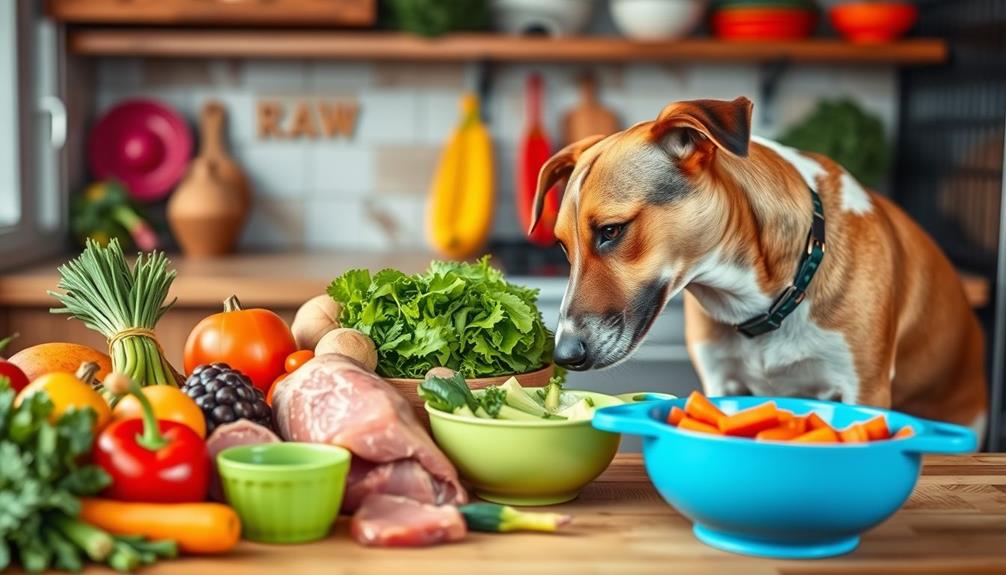
Shifting your dog to a raw diet can be an exciting journey that promotes better health and liveliness. To guarantee a smooth shift, aim to gradually change their diet over 7-10 days. Start with a mix of 25% raw and 75% current food for the first three days, then move to a 50/50 ratio, followed by 75% raw, and finally reach 100% raw by Day 10.
It's essential to monitor your dog's response throughout this process. Some dogs adapt quickly, while others may need more time. The typical daily intake for a raw diet is about 2-5% of your dog's body weight, adjusted according to their activity level and health status. Utilizing raw dog food calculators can help you determine the precise amount needed for balanced nutrition.
Implementing gradual changes in diet minimizes gastrointestinal upset, allowing your dog to adapt more comfortably to their new diet. Here's a quick reference table to guide you:
| Day | Raw Food Percentage | Current Food Percentage |
|---|---|---|
| 1-3 | 25% | 75% |
| 4-6 | 50% | 50% |
| 7-10 | 100% | 0% |
Portion Sizes and Guidelines
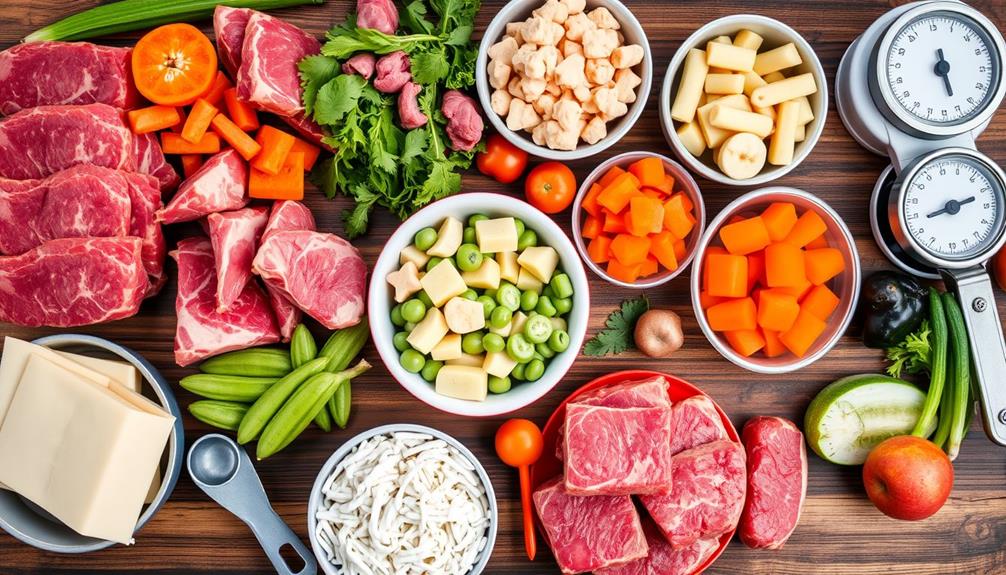
When determining portion sizes for your dog's raw diet, consider factors like their weight, age, and activity level to guarantee balanced nutrition. The recommended daily intake of raw food typically ranges from 2-5% of your dog's body weight.
Additionally, it's important to recognize that just as with human development, key domains of development can affect your dog's nutritional needs as they grow and change.
To help you establish appropriate portion sizes, here's a quick feeding guide:
- Small Breeds (15 lbs or less): Aim for 5 to 8 ounces of raw food daily.
- Medium Breeds (50-100 lbs): Expect to provide 1-3 lbs of food per day, depending on their activity level.
- Adjusting Portions: Increase portions for active dogs and decrease for those needing to lose weight, targeting a 40% reduction in calorie intake if necessary.
It's vital to adjust portion sizes based on your dog's unique needs. Use online raw dog food calculators and feeding guides to tailor recommendations based on their specific body weight in raw food.
This approach guarantees a healthy and balanced raw dog food diet, promoting better feeding habits for your furry friend. Always monitor your dog's condition and adjust accordingly to maintain their overall health.
Special Considerations for Dogs
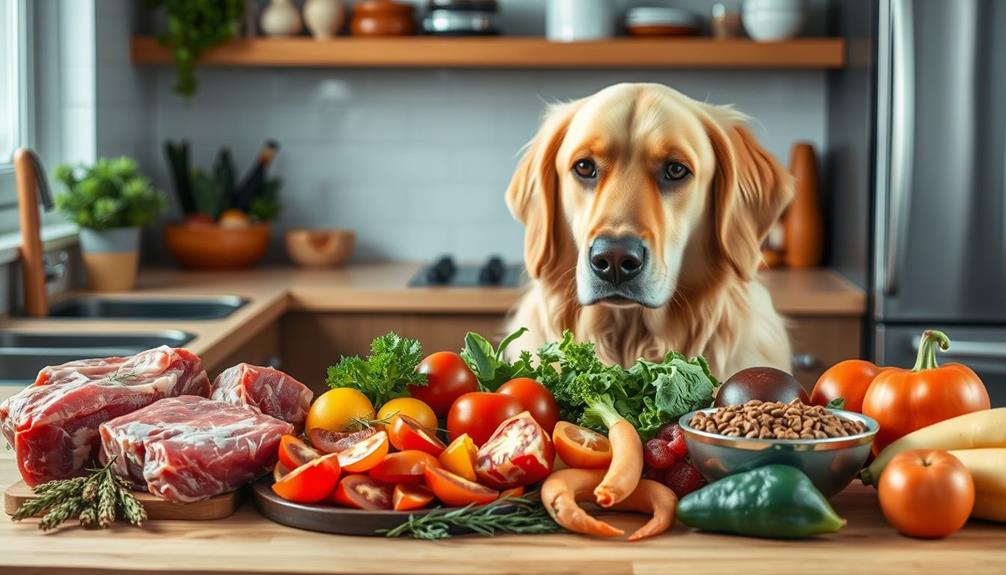
Special considerations for dogs on a raw food diet can greatly impact their health and well-being. If you have pregnant dogs, it's vital to maintain their regular diet during the first two trimesters. However, during the third trimester, you should increase their caloric intake by 5-10% to support milk production for their puppies.
Additionally, understanding the emotional and behavioral needs of your dog can help in managing their overall health, as stress can exacerbate certain conditions. For more insights on managing emotional stability in pets, refer to the role of emotional dysregulation.
For senior dogs facing health issues like obesity or arthritis, dietary adjustments may be necessary, including regular monitoring and potential increases in protein intake to offset muscle mass loss.
When it comes to large breed puppies, they need about 50-60% of their body weight in ounces of raw food. Adult large breeds, on the other hand, require 2-3% of their body weight daily for balanced nutrition. Be mindful of caloric intake, especially for large breed pregnant and lactating dogs, as you may need to adjust their food volume based on litter size.
Lastly, if your dog has specific health conditions, such as kidney or liver issues, consult your vet before considering high protein raw diets. Vet guidance is essential to guarantee a safe shift and proper dietary adjustments.
Cost-Effective Raw Feeding Tips

Feeding your dog a raw food diet doesn't have to break the bank; with a few smart strategies, you can keep costs manageable while guaranteeing your pup gets the nutrition they need. Here are some cost-effective tips to take into account:
1. Bulk Buying: Purchase raw meat in bulk from local butchers. They often offer lower prices on off-cuts and meaty bones ideal for dogs. Freeze portions to save money long-term.
Additionally, utilizing proper diet recommendations can help guarantee you're providing balanced nutrition without overspending.
2. Meal Planning: Plan meals in advance to take advantage of sales and seasonal pricing on raw ingredients. This approach can greatly reduce your overall expenses.
3. Affordable Ingredients: Incorporate affordable ingredients like eggs, organ meats, and seasonal vegetables. These can enhance your dog's diet while keeping costs down compared to premium cuts of meat.
Additionally, check out local farmer's markets or co-ops for fresher and often cheaper raw food options than conventional suppliers.
Engaging with community groups or forums focused on raw feeding can also help you discover discounts and shared resources for sourcing cost-effective raw food.
With these tips, you can provide a nutritious raw food diet without overspending.
Resources for Raw Feeding Support
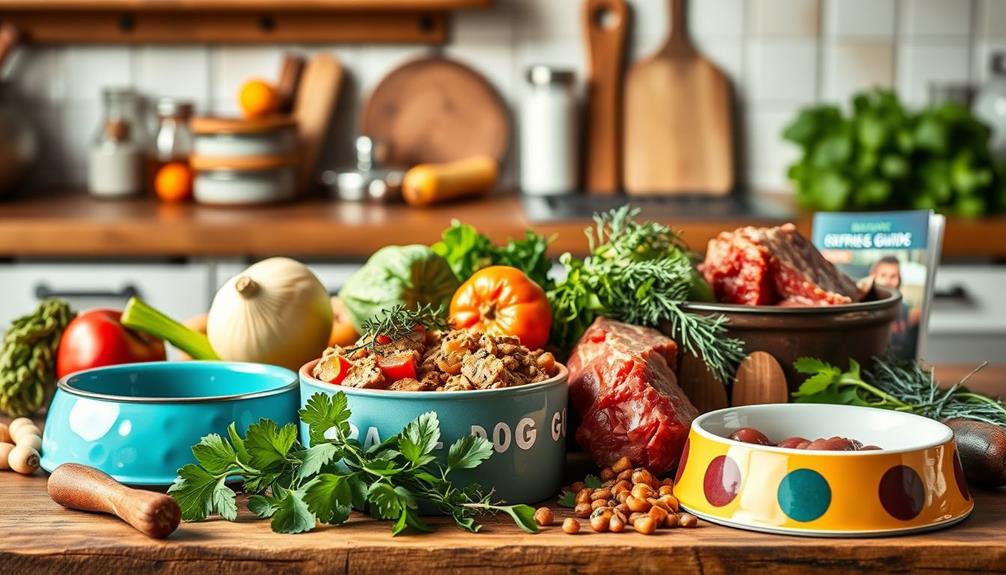
Steering through the world of raw feeding can be overwhelming, but plenty of resources are available to support you on this journey. As a pet owner, you can tap into various community resources like local butcher shops, where you can source cost-effective raw meat, offal, and meaty bones for your dog's diet.
Additionally, understanding the importance of yarn for scarves can help you find creative ways to repurpose scraps into cozy pet blankets or toys.
To help you determine the right amounts to feed, utilize online raw dog food calculators that factor in your dog's weight, age, and activity level, ensuring a balanced raw diet.
Furthermore, educational materials, including eBooks and articles from veterinarians, can guide you in maintaining nutritional balance and addressing any potential health risks.
Don't underestimate the power of connection; engaging in raw feeding forums and social media groups can provide invaluable raw feeding support.
These platforms allow you to share experiences and advice with other dog owners who are also shifting to a raw diet. By leveraging these resources, you can confidently navigate the raw feeding landscape and provide your furry friend with the best possible nutrition.
Frequently Asked Questions
What Is a Complete Raw Diet for Dogs?
A complete raw diet for your dog includes 70% muscle meat, 10% raw bones, 7% vegetables, 5% liver, and 5% other organs, ensuring balanced nutrition. Don't forget to contemplate supplements for ideal health!
What Is the Raw Feeding Guide for Dogs?
Think of your dog's diet as a colorful palette. The raw feeding guide suggests balancing muscle meat, bones, veggies, and organs, ensuring variety and gradual shift for ideal health. You'll create a masterpiece of nutrition!
What Raw Food Can I Feed My Dog Daily?
You can feed your dog a mix of muscle meat, raw bones, vegetables, and organ meats daily. Adjust portions based on your dog's weight and activity, rotating protein sources for a balanced, nutritious diet.
Do Vets Recommend a Raw Diet for Dogs?
Vets often have mixed opinions on raw diets for dogs. While some may recommend them for specific health issues, many emphasize balanced nutrition and caution against potential risks like bacterial contamination. Always consult your vet first.
Conclusion
In summary, raw feeding can be a fantastic way to boost your dog's health, much like giving them a gourmet feast every day. By understanding the benefits, knowing the right ingredients, and taking necessary precautions, you can guarantee your furry friend thrives on a raw diet. Remember to shift gradually and keep an eye on portion sizes. With a little planning and effort, you'll be well on your way to providing your pup with a nutritious and satisfying meal.

